Genre: Action Developer: Bullfrog Productions Publisher: Electronic Arts Players: 1 Released: 1994
Pity poor cyberpunk. Much like the cyberspace its visionaries sought to describe, the genre’s potential went on to grow beyond expectations until it became diluted and common place, unable to spark our fascinations any longer as most of its predictions had become redundant or unfashionable over the years. Artificial intelligence looms on the horizon, and the World Wide Web became a ubiquitous commodity. Mirror shades and overcoats… Not so much.
But its futuristic paranoia and noir themes have found their way into pop culture, from Shadowrun to Akira and The Matrix. Even today, some gamers would gladly trade their elves for cybernetic implants, their magical kingdoms for oppressive dystopias, and ditch spells for a good old shotgun. Bullfrog’s Syndicate, with its sprawling levels, tactical combat, and strategic layers, is perhaps one of the finer examples of the genre. But how well does the Genesis version of the seminal game fare?
The fiction stays true to its roots, at least, splicing the dangers of unrestrained capitalism with cyborgs, urban decay, and nihilism. Nations are controlled by multinationals who turn consumers into zombies and highly trained killers to further their agenda. Assassination, mind-control, and extortion are common place in the world, as are cybernetic augmentations and sci-fi weaponry that can reduce a handful of cheerful people into paste or screaming, extra crispy toast.
Hmm, crispy. That flame-thrower was awesome.
Sadly, that is one of the finer points of the game strangely amiss in this Genesis version. Sound wise it’s incredibly muted, with a functional blip and bop soundtrack and minimal use of sound effects – no more terrifying cries of helpless citizens watching their skin burn. One can’t really blame the hardware though, since the 16-bit machine was more than capable of providing good quality output, even if not up to the standards of Bullfrog’s game. The gritty environments and overall dark tone also gave way to a slightly garish color scheme and super deformed character sprites, but the sparse levels still try their best to highlight the high tech yet sparse urban sprawls featured in the original title. But then, it’s the game that counts, right?
At its dark little heart, Syndicate has you managing wider global operations and then placing you in the frontlines. You start as a fresh executive for a multinational corporation and your job is to prevail above the competition. At the start a world map shows your corp.’s grasp over the world, giving you information such as the degree of control you have over countries and how much taxes you can squeeze out of them – required to generate enough income to fuel your investment in technological research (like types of weapons or drugs that stimulate agent response and accuracy) and upgrades (such as subdermal plate armor for added defense or bionic legs providing a faster rate of movement). Being a conservative ruler is a slow but steady way to generate resources; raise taxes too high and you’ll get rich quicker but always at the edge of the seat, with riots and loss of confidence risking loss of territory.
Each mission is then preceded by a choice of weapon loadouts and mechanical upgrades for your quartet of thugs. Choices weighed and made, it’s time to dwell into the best part of the game. Syndicate’s missions ranked as some of the hardest in any game at the time of its original release and some of that difficulty made the transition to Sega’s 16-bit wonder. What starts out as a simple pacification of unruly citizens or a public execution of the opposition makes a sharp turn into more delicate missions, such as mind-controlling and kidnapping a scientist or taking down a number of key targets amidst streets patrolled by agents from other corporations and law enforcers.
Mission objectives aren’t terribly varied but they get increasingly tricky, with the handful of skirmishes during the early moments of the game doing a poor job of preparing you for the larger gunfights further down the road. Its fifty missions across the globe are often uncompromising; with an open-ended structure and layout that often trades difficulty curves for steep hills. It’s in sharp contrast to games like Shining Force which, while hard on their own, had a much more comfortable sense of progress. Here, the real-time combat can be punishing as it not only requires you to often develop tactics on the fly but also expects you to have soaked up a bit of experience in the strategy component, so as to prepare and deploy more efficient troops. It’s part world-conquering and part party-building with a dash of reflexes.
This would be fine in itself if not for a few issues. Missions are presented through an isometric perspective, giving enough sense of the environments and enemies but you can never see characters that enter buildings or go behind them. It becomes a tricky proposition to keep track of your group through a small colored arrow and guessing if the on-screen bullseye is planted over a mission objective or a handful of rowdy droids that simply don’t like your use of the old ultra-violence. Surviving certain conflicts is often a matter of luck or desperately looking at the radar on the lower part of the screen and its green, red and white square depictions of friend, foe and neutral units.
The final level of the DOS original, Atlantic Accelerator, makes a return with a fiendish difficulty and twisting paths of its own and by then, you need the best squad money can buy and be comfortable with the navigation display. A lot easier said than done. Thankfully, you can use your group in various ways: as a tight group of four, as a two man squad or send a lone agent so as to not draw attention with a bigger party. This is instrumental in some missions when you need to flank exits, provide cover or even save some cash and let a one man army do the job. Of course, any method that involves less than four leaves the unused party members stationary and therefore open to attacks, so some care and planning is always required.
The problem, however, is how you go about this. While the interface is generally competent and not terribly obtuse, it does take a bit getting used to its quirks. Adapting a complicated PC control scheme wouldn’t be easy and it shows: each button has a context-specific action, which can be activated by holding A, B or C while cycling through other options with the directional pad. The ability to pause lets you breathe for a while but provides small comfort and will slow you down during the more heated battles. Your agents also pick up nearby weapons and items off the ground, which is useful… When they’re not going for the duds you just discarded seconds ago. If you don’t pay attention the end result might be finding your last surviving agent in a Mexican stand-off, armed to the teeth but out of ammo. Mission fail, money lost, frustration rising is a pattern that happens a lot. The game’s choice of a password system to save your data can sometimes make it worse as it tends to “forget” your progress in tech development unless you reach its top tiers.
Nowadays it might be hard to appreciate a game like Syndicate as its open-ended structure, violence and satirical punches at media and culture have been surpassed by the likes of Grand Theft Auto. Even similarly-themed games at the time like Shadowrun had more presence and variation. Sadly, the Genesis version lacks some refinement in nearly all major aspects but it’s a testament to the quality of the original design that there are still enjoyable moments to be had. And when you’re pumping some poor politician with a Gauss Rifle, persuading mobs to act as human shields or temporary comrades in arms, or even hijacking a car to perform drive-by shootings against agents and droids, it’s the concept that pulls at you – not the execution.
Syndicate stands as another “could have been” in the Sega Genesis library. Depressing, considering how much care went into other Bullfrog productions that made the jump like Populous. Its matter-of-fact graphics, dead pulse music and difficulty spikes make an otherwise good game uninviting. But if you let yourself sink into its light but pervasive strategy layer, forgive the controls and bask in the warmth of the amoral mayhem you can cause, and appreciate the replayability found in the missions and in customizing your corp. goons, there’s a lot of game here.
SCORE: 6 out of 10


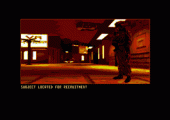
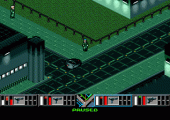
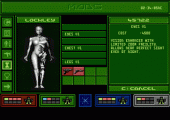
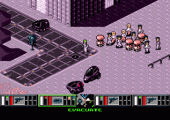
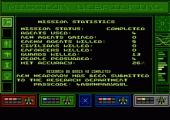
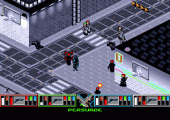
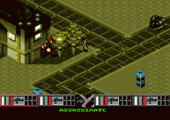
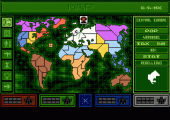
Recent Comments